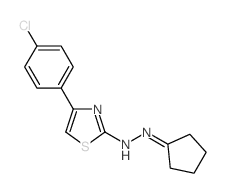CPTH2

CPTH2 structure
|
Common Name | CPTH2 | ||
|---|---|---|---|---|
| CAS Number | 357649-93-5 | Molecular Weight | 291.79900 | |
| Density | N/A | Boiling Point | N/A | |
| Molecular Formula | C14H14ClN3S | Melting Point | N/A | |
| MSDS | Chinese USA | Flash Point | N/A | |
Use of CPTH2CPTH2 is a potent histone acetyltransferase (HAT) inhibitor. CPTH2 selectively inhibits the acetylation of histone H3 by Gcn5. CPTH2 induces apoptosis and decreases the invasiveness of a clear cell renal carcinoma (ccRCC) cell line through the inhibition of acetyltransferase p300 (KAT3B)[1][2]. |
| Name | 4-(4-chlorophenyl)-N-(cyclopentylideneamino)-1,3-thiazol-2-amine |
|---|---|
| Synonym | More Synonyms |
| Description | CPTH2 is a potent histone acetyltransferase (HAT) inhibitor. CPTH2 selectively inhibits the acetylation of histone H3 by Gcn5. CPTH2 induces apoptosis and decreases the invasiveness of a clear cell renal carcinoma (ccRCC) cell line through the inhibition of acetyltransferase p300 (KAT3B)[1][2]. |
|---|---|
| Related Catalog | |
| Target |
GCN5 p300 |
| In Vitro | CPTH2 (100 μM; 12, 24, 48 hours) causes a decrease in cell proliferation after as early as 12 h with a further significant reduction after 48 h stimulation[1]. CPTH2 (100 μM; 12 or 48 hours) causes a comparable drop of the activity in both cell lines[1]. CPTH2 (100 μM; 48 hours) produces a drastic increase in apoptotic/dead cell population after 48 h[1]. CPTH2 (100 μM; 12, 24, 48 hours) shows a reduced acetylation of both global AcH3 histone and H3AcK18[1]. CPTH2 (100 μM; 24, 48 hours) is capable to counteract invasion and migration of ccRCC-786-O cells in culture[1]. CPTH2 (0.2, 0.5, 1 mM) inhibits the growth of a GCN5 deleted strain and a single catalytic mutant E173H[2]. CPTH2 (0.6, 0.8 mM; for 24 hours) inhibits histone H3 acetylation in yeast cell cultures[2]. CPTH2 inhibits the Gcn5p dependent functional network[2]. Cell Proliferation Assay[1] Cell Line: Papillary thyroid (K1) and clear cell Renal Cell Carcinoma (ccRCC-786-O) cell lines Concentration: 100 μM Incubation Time: 12, 24, 48 hours Result: Caused a decrease in cell proliferation after as early as 12 h with a further significant reduction after 48 h stimulation. Cell Viability Assay[1] Cell Line: K1 and ccRCC-786-O cell lines Concentration: 100 μM Incubation Time: 24 hours (K1 cell) and 48 hours (ccRCC-786-O cell) Result: Caused a comparable drop of the activity in both cell lines. Apoptosis Analysis[1] Cell Line: ccRCC-786-O cells Concentration: 100 μM Incubation Time: 48 hours Result: Produced a drastic increase in apoptotic/dead cell population after 48 h. Western Blot Analysis[1] Cell Line: ccRCC-786-O cells Concentration: 100 μM Incubation Time: 12, 24, 48 hours Result: Showed a reduced acetylation of both global AcH3 histone and H3AcK18. |
| References |
| Molecular Formula | C14H14ClN3S |
|---|---|
| Molecular Weight | 291.79900 |
| Exact Mass | 291.06000 |
| PSA | 65.52000 |
| LogP | 4.87840 |
| Storage condition | 2-8°C |
| RIDADR | NONH for all modes of transport |
|---|
| Precursor 2 | |
|---|---|
| DownStream 0 | |
|
c-ETS transcription factors play an essential role in the licensing of human MCM4 origin of replication.
Biochim. Biophys. Acta 1849 , 1319-28, (2015) In metazoans, DNA replication is a highly regulated and ordered process that occurs during the S phase of cell cycle. It begins with the licensing of origins of replication usually found in close prox... |
| cpth2 |

